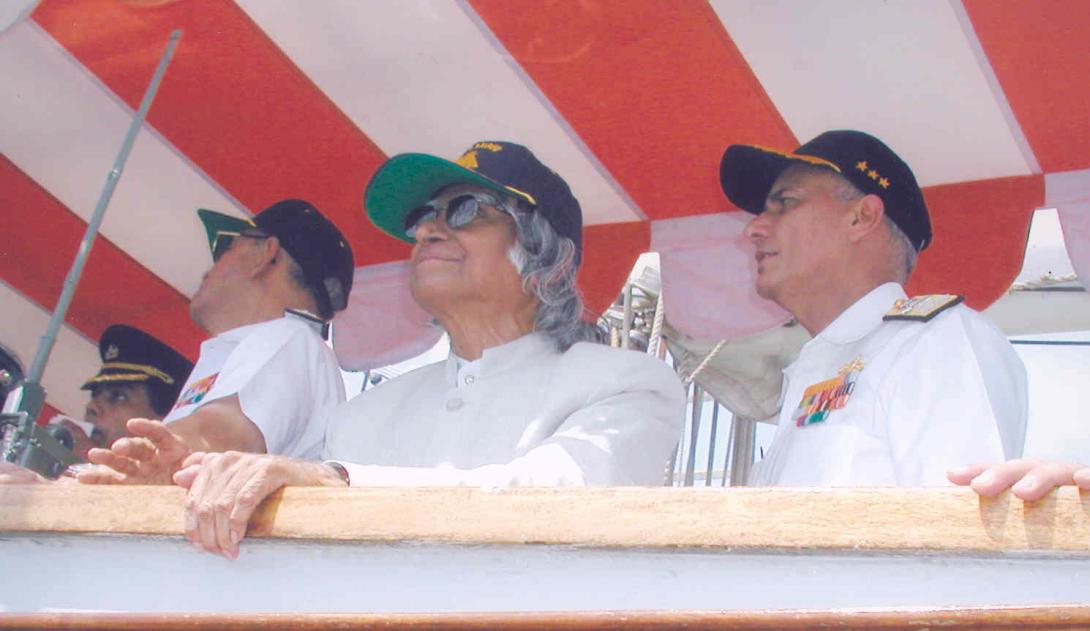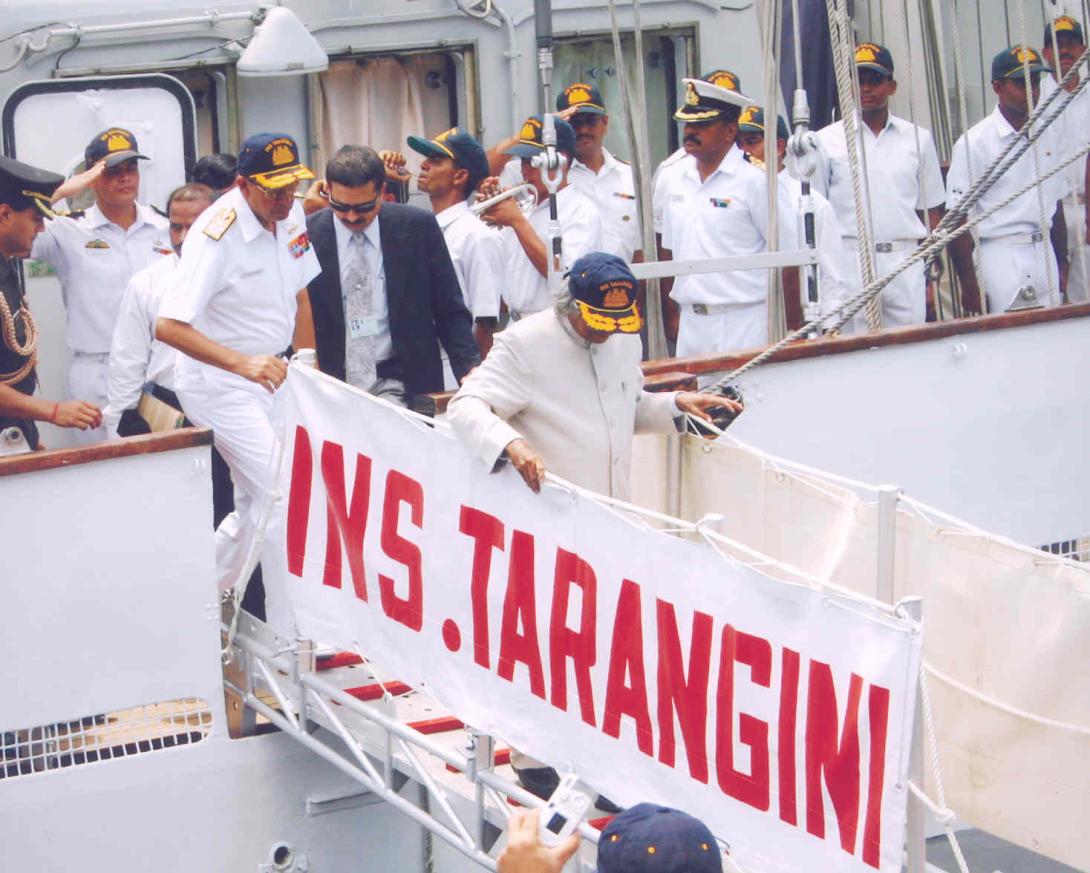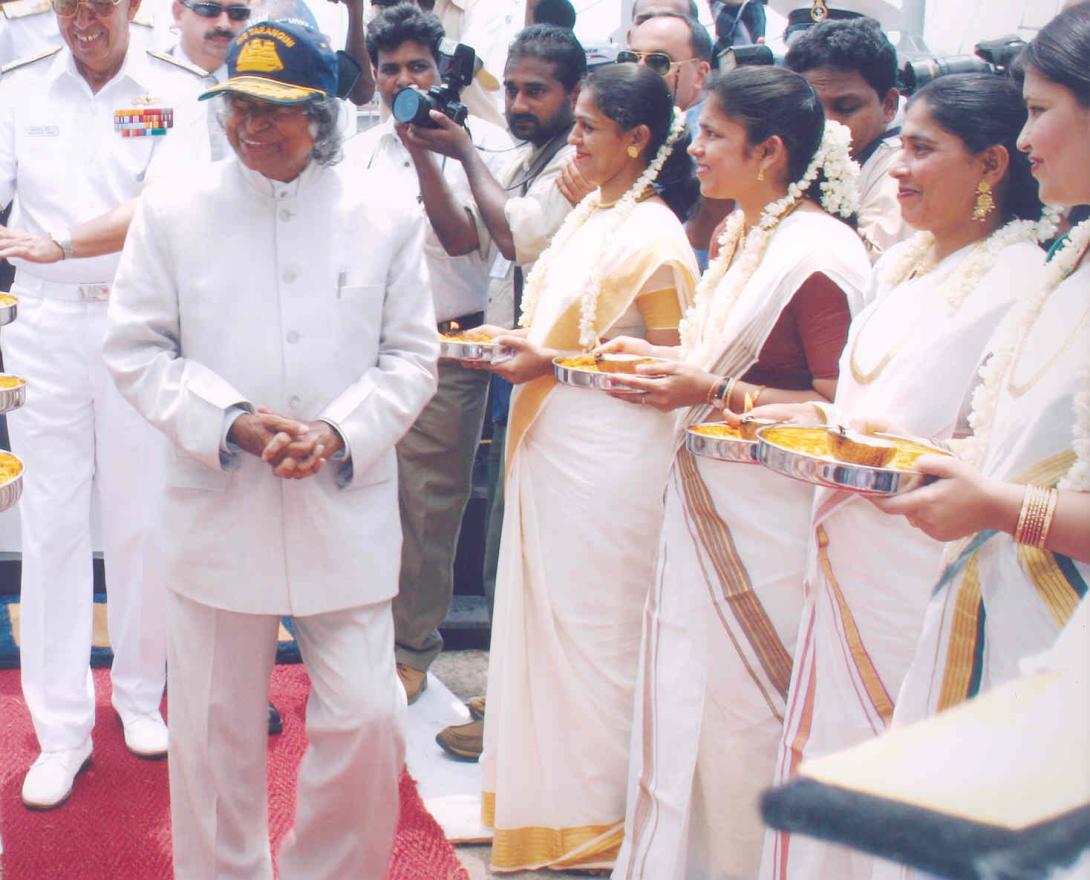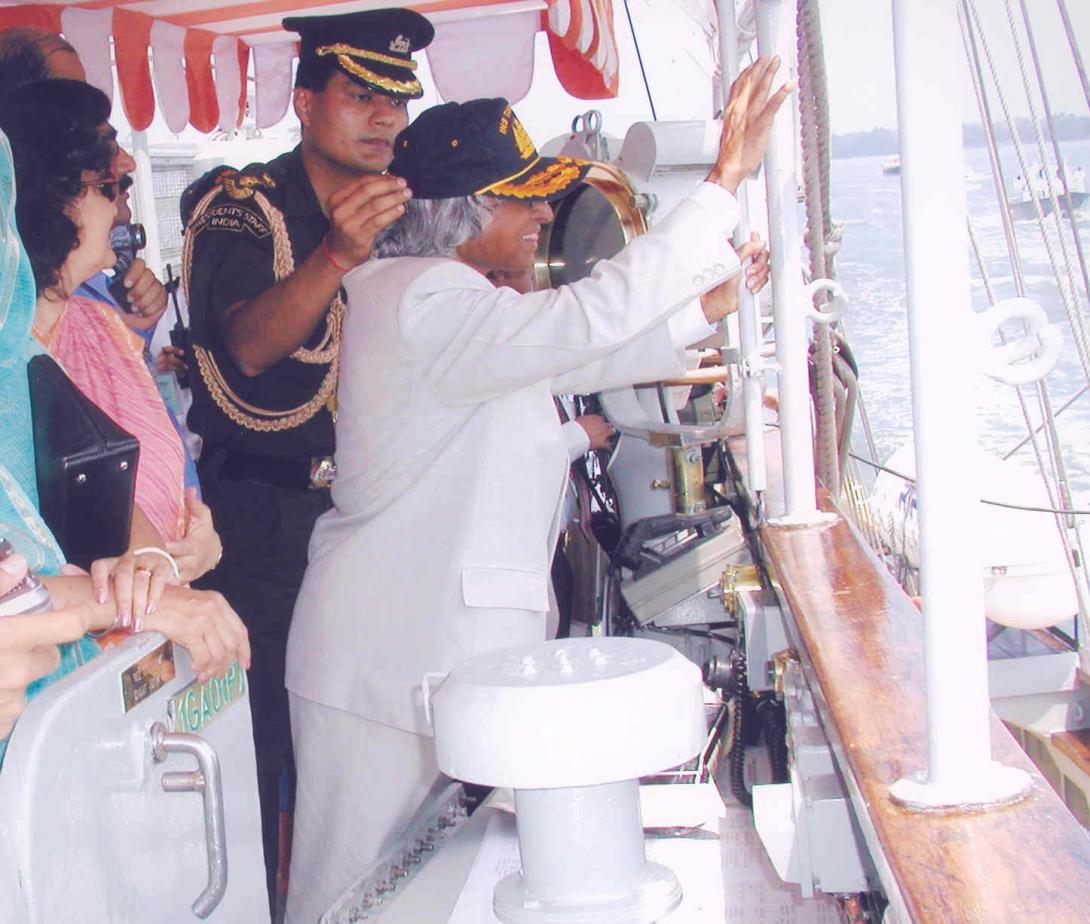Address During the Welcome Ceremony of the Naval Ship, Ins Tarangini
Kochi : 25-04-2004
Tarangini: The Waves of Experiences
I am indeed delighted to participate in the welcome ceremony of the Naval ship INS Tarangini, which has been in voyage for over fifteen months. My greetings to the planners and organizers of this mission, naval officers, naval crew and the cadets for making this mission a great success.
The Great Voyage
Adventure creates an environment of curiosity. Curiosity provides enthusiasm. The combination of curiosity and enthusiasm leads to high thinking. Thinking results into hard work, which in turn results into action. INS Tarangini is the combination of all these phenomenon, which commenced its circumnavigation voyage from Kochi and has now returned to the same port.
You have indeed re-established the tradition of sea voyage of Columbus with the purpose, which commenced in 1492 and took nearly 8 months to travel approximately 3000 nautical miles in his first voyage starting from Palos, Cuba, Hispaniola, and Azores and then reached again Palos. Now the Tarangini has taken 15 months to cover 33,000 nautical miles, which is almost 11 times in terms of distance and has just taken twice the duration. Columbus had discovered new continent through his mission, whereas you have travelled through all the continents except Antarctica and won the hearts of the people of the continents wherever you had visited. Also this great sea voyage has enabled the Navy to provide training to the cadet-officers. Your Logbook may reveal some new interesting aspects about what you had seen and experienced during this Voyage.
Unique role of Navy
Sea voyage is indeed enchanting. Waves give music, some times waves give awe, and waves also give challenge when you cruise, which you have experienced in this mission. When I think about Navy I realize that this arm of armed forces has a unique role during the war and also in peacetime. During the war you are ensuring that all sea routes are made safe and no intrusion takes place from the sea into the country. Also during peacetime you are ensuring safe passage of all commercial commodity movement including oil in our zone.
Historically if you look at our country, there have been many land-based invasions from the central Asia in the northern parts of India from multiple kings and warriors. These invasions led to a series of problems and pain. But surprisingly in the name of trade and subsequent invasions, which took place through the sea route, engulfed the nation like a wild fire. The Portugese entered into India in 1498 from the west coast. Later during the 16th century both Danish and French came to India at Tarangambadi and Pondicherry respectively through sea. During the 17th century the Britishers came to India and formed a trading company again through sea. They virtually overpowered Portugese, French and Danish. The British ruled India for over 250 years. Also there were some isolated colonies of other three nations. This really reveals that economic war was waged from the seas, and also the war for ruling India was carried out through sea routes and sea journey.
Swadeshi movement
Chola kings in 10th century set sea voyages to Burma, Malaya and Sumatra, while suppressing the activities of the pirate of the Sumatra warlords. India?s freedom movement commenced in 1857 in Meerut and in 1906 it took a different form of challenge to the British. Freedom fighter V.O.Chidambaram Pillai formed Swadeshi Steam Navigation Company Ltd., not as a mere commercial venture, but to lay the foundation for a comprehensive shipping industry in the country. Against all odds, V.O.Chidambaram Pillai succeeded in defeating the designs of the alien rulers who wanted to nip the swadeshi initiative in the bud. Contrary to the calculations of the British that it would collapse like a house of cards, the company not only survived but also threw a tough challenge to the colonialists.
In this context, navy has an important role in safeguarding against intrusion of different types through the sea routes: intrusion into economic entities - for example our islands and protection of national wealth on the sea, above the sea and under the sea. Your sea journey, Tarangini voyage, indeed will ensure that in future there will not be any subjugation of Indian Territory or dangers to our sea borne economic activity. And thereby the Indian navy has proclaimed the peace message.
My father?s sail boat
When I am in the midst of Naval environment, I am reminded of my childhood experience, which I would like to share with you. I was about six years old (1937) when my father embarked on the project of building a wooden sailboat to take pilgrims from Rameswaram to Dhanushkodi, (also called Sethukkarai), and back. He worked at building the boat on the seashore, with the help of a few experienced carpenters. The wooden hull and bulkheads were seasoned with the heat from wood fires. I watched the boat taking shape. Then the sailboat was built and launched. Since the sailboat was new and it could carry 40 passengers, it became popular and led to good earning and it was a big resource for my education. One day, suddenly a cyclone bringing winds of over 100 miles per hour carried away our boat, along with some of the landmass of Sethukkarai. The Pamban Bridge collapsed with a train full of passengers on it. Until then, I had only seen the beauty of the sea, now its uncontrollable energy came as a revelation to me. Such storms are common experience for all of you particularly in the Navy.
Challenges with nature
I was told that INS Tarangini was also caught in a Mediterranean storm and its sails measuring a total of 1000 square meters were torn. I can imagine the challenges faced by the crew in such a situation. Fresh sails were flown down our country, but for a day or two you stitched the torn sails and kept going. Tackling such situations put to test ingenuity, innovation and sea-faring skills of the crew.
Experience in a full moon night
I would like to share another small incident, which I experienced, when I was working with DRDO (1999). It was a full moon night in the Wheeler Island. We launched the operationalized version of Agni. The launch was a textbook launch and the mission requirements were fully met and re-entry vehicle went exactly to the target. It was a great joy. After the first phase of post flight analysis, I had to rush to Dhamra, then to Chandipur and next day morning to Calcutta so that I can reach for the LCA Review at Bangalore. I was going in a powered boat from Wheeler shore to Dhamra shore, which normally takes 40 minutes. We were enjoying the ride, my self, Dr. S.K. Salwan and Shri S.C. Narang in the full moon night. The sea was very rough, the waves were rocky and the cold and salty water was being sprayed on us. To our great surprise, in the midway from Wheeler Island to Dhamra, the engine of our boat stopped functioning. Imagine an engineless boat with no sails on a full moon night, when the sea is very rough. Almost the rocky waves were showing its strength on our boat. Except the boatmen, and me none of the others could swim. Everybody was frightened.
When people were afraid and jittery about what is going to happen, I had to keep their minds busy and free from fear. So, I told them my experiences with the sailboat that my father had built for ferrying the pilgrims from Rameshwaram to Dhanushkodi. As a small boy, I was given the job of continuously emptying the water from the boat, which used to come inside due to leakage from wodden hull. For emptying the water during to and fro journey, I used to get a bonus of one Anna. This experience gave a sense of happiness to my colleagues. Meanwhile, using the boat?s communication we could contact the other boat, which reached us after a short while. All of us got ourselves transferred to the new boat and reached Dhamra. When such a very short distance travel of about 30 km in one full moon night gave us anxious moments, I can imagine how the crew and cadets of Tarangini would have felt and experienced during the long journey of 33,000 nautical miles traversed in more than 15 full moon nights. I have been informed that you did not use the engine except when you were crossing the equatorial doldrums powered by winds. This is a good test of endurance for the crew and the trainees.
Training and teachers: INS Tarangini
For the inmates of INS Tarangini, the sea is the classroom and the elements of nature are the teachers. This sail ship is the basic building block of India?s naval training. In a fast changing world of marine technology the INS Tarangini proudly carries the sails, the wheel and the compass, the basic methods with which seamen of yester years cross the oceans, found new territories, established empires like Britishers and knitted the world with trade and commerce.
INS Tarangini a three masted sail ship might not be India?s most advanced ship but it is where the Indian navy teaches and tests its officers and sailors before entrusting them with modern warship. Even in today?s high-tech world sail ship teaches the cadet basics, that no navy can do without. Sailing brings out the qualities of camaraderie, teamwork and the spirit of adventure. You are there with the sea and the winds and you get to understand the nature and they become your friends.
Conclusion
You crossed the Indian Ocean, you crossed the Atlantic Ocean, you crossed the Pacific Ocean and you have come back to Kochi again through Indian Ocean. In this long journey we greet the notable achievement of INS Tarangini crossing the Atlantic Ocean covering four thousand nautical miles in a single stretch.
INS Tarangini also took me to early Indian history, I used to ask myself why our country had been invaded by many, Alexander the great, Central Asian Kings and warriors, Afghan kings and warriors and then British rulers ruled for a long time (250 years). Did we not have warriors? Did we not have kings with adventurous spirit and did we not have kings with ambitions. The fifteen months mission of INS Tarangini beautifully answered this question. India always had a unique
Philosophy of life. I would like to quote ?Puranaanuru?, a Tamil epic (Composed 2000 years ago). It means the whole world is one single village. And all the people are our kith and kin. INS Tarangini has indeed established this spirit and it has flown India?s flag of peace in all parts of the world.
I am also happy to note that INS Tarangini was serviceable throughout during this long demanding journey, which shows the ship building capability of our Goa Shipyard and Indian navy. I congratulate all of you.
I would suggest the three Commanders and some of the team members who participated in this mission should work together and write a book on their experiences of this circumnavigation mission, which I am sure, will be an inspiring document for the Indian Navy and will also be useful for training purposes and above all it will be a book of great sea journey and sea experience.
My best wishes to the entire naval community for success in the present and in the future missions.
May God bless you.




